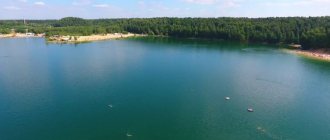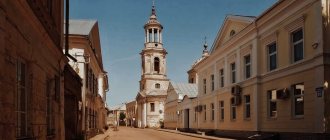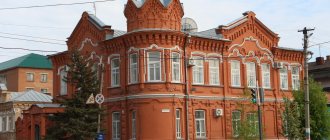Zavitinsk
(Amur region)
OKATO code:
10221501
Founded:
1906
Urban settlement since:
1936
City since:
1954 City of district subordination (Zavitinsky district of the Amur region)
Center:
Zavitinsky district
Telephone code (reference phone)
| 41636***** | 22-2-31 22-2-32 |
Deviation from Moscow time, hours:
6
Geographic latitude:
50°07′
Geographic longitude:
129°26′
Altitude above sea level, meters:
230 Sunrise and sunset times of the Sun and Moon in the city of Zavitinsk
Map
| Zavitinsk: maps |
Zavitinsk: photo from space (Google Maps) Zavitinsk: photo from space (Microsoft Virtual Earth)
| Zavitinsk Nearest cities. Distances in km. on the map (in brackets along roads) + direction. Using the hyperlink in the distance , you can get the route (information courtesy of the AutoTransInfo website) | |||
| 1 | Raichikhinsk | 35 (74) | YU |
| 2 | Ekaterinoslavka | 37 (209) | NW |
| 3 | Progress | 44 (64) | YU |
| 4 | Novobureysky | 46 (49) | SE |
| 5 | Romny | 68 () | WITH |
| 6 | Poyarkovo | 78 (86) | SW |
| 7 | Vozzhaevka | 86 (246) | NW |
| 8 | Arhara | 88 (154) | SE |
| 9 | Tambovka | 98 (120) | Z |
| 10 | Ivanovka | 106 (153) | Z |
| 11 | Belogorsk | 111 (231) | NW |
| 12 | Konstantinovka | 117 (179) | SW |
| 13 | Seryshevo | 132 (254) | NW |
| 14 | Blagoveshchensk | 136 (166) | Z |
a brief description of
Located on the Zeya-Bureinskaya Plain, 227 km east of Blagoveshchensk. Railway node - Zavitaya station.
Territory (sq. km): 245
Information about the city of Zavitinsk on the Russian Wikipedia site
Historical sketch
Founded in 1906. In 1912, a railway line passed through the village, and in 1914, the Zavitaya station was opened. Name by river Curved (the left tributary of the Amur), which seemed very winding to the discoverers.
Since 1936, the working village of Zavitaya. In 1954 it was transformed into the city of Zavitinsk.
Economy
Railway transport enterprises, canning and butter factories, bakeries, etc.
Hatchery station, beekeeping state farm "Maisky".
In the Zavitinsky district, wheat, oats, barley, buckwheat, and soybeans are grown. They raise cattle, pigs, and poultry.
Deposits of glass sands and refractory clays.
Architecture, sights
The modern development of the city is formed in the form of residential microdistricts.
| Population by year (thousands of inhabitants) | |||||||
| 1939 | 11.7 | 1996 | 21.7 | 2007 | 13.2 | 2015 | 10.9 |
| 1959 | 16.0 | 1998 | 20.7 | 2008 | 13.0 | 2016 | 10.8 |
| 1967 | 19 | 2000 | 19.3 | 2010 | 12.7 | 2017 | 10.7 |
| 1970 | 19.0 | 2001 | 19.1 | 2011 | 11.5 | 2018 | 10.7 |
| 1979 | 17.5 | 2003 | 14.2 | 2012 | 11.3 | 2019 | 10.4 |
| 1989 | 21.8 | 2005 | 13.4 | 2013 | 11.1 | 2020 | 10.2 |
| 1992 | 22.3 | 2006 | 13.4 | 2014 | 11.0 | 2021 | 10.0 |
Story
Zavitinsky district was formed in 1926 and covers an area of 3.3 thousand square kilometers. Located in the southeastern part of the Amur region in the east of the Zeysko-Bureinskaya Plain. The administrative center is the city of Zavitinsk - the city of Zavitinsk (formed in 1954), located 170 km from the regional center of Blagoveshchensk.
In the north it borders with the Romnensky district, in the east with Bureya and the lands of the city of Raichikhinsk, in the south with Mikhailovsky and in the west with Oktyabrsky districts. Communication with the regional center is carried out via the Vladivostok-Belogorsk-Blagoveshchensk railway and via the federal highway Blagoveshchensk-Zavitinsk.
In December 1858, the Amur Region was established, which in turn was divided into volosts. One of these volosts was Zavitinskaya, which received its name from the Zavitaya river. The territory of the newly formed volost covered, when compared with the current administrative-territorial division, Mikhailovsky, Bureisky and Zavitinsky districts.
As of 1894, there were 20 settlements in the volost. All of them were located along the banks of the Zavitaya, Bureya, Dim, Raichikha, Polovinka and Khar-Bir rivers. There were 686 households in which 5,540 people lived. Land was distributed at the rate of 27 acres per capita.
The settlement of the area began in 1865, when the village of Platovo was formed on the Zavitaya River and was named after the first settler.
The resettlement process became continuous. From year to year, more and more new settlements appeared on the map of the region. The first volunteer settlers were peasants from the interior regions of European Russia, Ukraine, Belarus and Siberia.
In 1881, on the Polovinka River, on a hillock, the village of Innokentyevka was formed, which received its name in honor of Innokenty Viniaminov, the first Amur Bishop, then the Patriarch of Moscow.
In 1890, the village of Bely Yar was founded. It got its name from the steep white cliff on the opposite bank of the Zavitaya River.
In 1892, the village of Valuevo appeared, named in honor of the Amur military governor A.M. Valueva. Until 1910, it was called Rogozhino, after the name of the first settler.
In 1897, the village of Kamyshenka was founded, named after the first settler Kamyshin.
During the entire period from the beginning of colonization until 1900, about 100 households settled in the area. More intensive settlement began in 1900. In the period from 1901 to 1909, a number of new settlements (686 families) arose in the region. The following villages appeared on the map of the area:
HEADING. Founded in 1902 by immigrants from the Kamenets-Podolsk region.
ANTONOVKA. Founded in 1902 under the name Uvalnoye, then renamed in honor of the first resident.
FEDOROVKA. Founded in 1902, named after the first settler Fyodor Sharapov.
ALBAZINKA. It arose in 1903 and was named after the icon of the Albazin Mother of God, first brought to the Amur by Hieromonk Hermogenes in 1665. The original name of the village was Pavlo-Petrovka.
USPENOVKA. Founded in 1903. Initially, the village was called Evseevka, in honor of the walker Evseev, who discovered and offered this site for settlement. Later the village received its modern name - the Dormition of the Mother of God.
NOVOALEXEEVKA. Founded in 1904. Until 1931 it was called Merkushka after the river of the same name.
BOLDYREVKA. Founded in 1906 and named after the regional land manager Boldyrev. Until 1910, the village was called Minskaya Sloboda, in honor of the first settlers from the Minsk region.
ENVY. The village was founded in 1906. The name comes from the winding river of the same name. Since 1912, Zavitaya became a railway station, in 1936 it was given the status of an urban-type settlement, and on November 18, 1954, the settlement became the city of Zavitinsk of regional subordination.
AVRAMOVKA. It was formed in 1908, named after its first resident.
VERKHNEILINOVKA. Founded in 1908. Named after the first settlers on the Amur, the Ilins.
DEMYANOVKA. Founded in 1908, it was named after the first settler.
TUR - railway station. Founded in 1912 as railway siding No. 30, since 1935 it has had its current name.
DEYA - railway station. Founded in 1912 as railway siding No. 31, since 1935 it has had its current name.
ZHITOMIROVKA. It was formed in 1918 by immigrants from the Zhytomyr region.
IVANOVKA. Founded in 1918 and named after the first settler.
TRANSFORMATION. Founded in 1918. Until 1929, the village was called Morozhennaya Pad.
Other settlements were also founded in the northern part of the region. From 1918 to 1924, resettlement to the area ceased. As of 1926, there were 30 villages and villages in the region, and 29 village councils worked.
From 1924 to 1930, a wide wave of settlers moved to the area, as it was sparsely populated. During this period, 5,000 people moved in.
In 1928, the village of CHERVONAYA ARMY was founded as a result of the planned resettlement of former Red Army soldiers and their families.
In 1929, the village of LENino was founded.
In 1929 KUPRIYANOVKA was founded. The name is derived from the Kuprianikha river of the same name, named after Ya.I. Kupriyanov, a member of N.N. Muravyov-Amursky’s expedition in 1854.
In 1935, in connection with the construction of the Zavitaya-Poyarkovo railway line, the DEMYANOVKA station arose.
In 1915, a flour mill came into operation, a number of small peasant mills, 6 oil factories, an oil depot, a brick factory and a flax processing plant, bakeries, grain harvesting, fur harvesting, etc. were built.
The revolution has begun. Soviet power came to Zavitinskaya volost in February 1918, but did not last long and was overthrown by internal counter-revolution and Japanese intervention. The Zavitinians took an active part in the struggle for the restoration of Soviet power. Thus, in the village of Zavitaya, in Kamyshenka, Avramovka, Valuevo and Verkhneilinovka, underground revolutionary fighting groups were created that provided comprehensive assistance to the partisan detachments “Starik”, “Makarova-Zubareva”, “Black Raven” and “Red Eagle” operating in the region.
In August 1919 in the village. Albazinka, Zavitinsky volost, a meeting of representatives of the largest partisan detachments in the region was held, at which the zoning of the detachments’ actions was carried out and a governing body was created.
45 Zavitin residents died during this hard time. The first chairman of the village revolutionary council, Konstantin Nesterovich Kursakov, also died heroically, hacked to pieces with swords.
After the expulsion of the Japanese interventionists from the Amur region in February 1920, fighters of the partisan detachments joined the Red Army units and continued the fight for the complete liberation of the Transbaikal and Primorsky regions.
In 1931-1932, collectivization took place in the region. It was carried out hastily, with excesses, without logistical and ideological support. Even greater excesses were made in the implementation of the policy of dispossession. And this, in turn, led to a sharp reduction in agricultural production.
As a result of collectivization, 31 collective farms (collective farms) were formed in the region: them. Stalin, named after Blucher, them. 9th Crimean Cavalry Division, named after. Voroshilov, them. Lazo, im. Kotovsky, named after. Kalinin, im. Budyonny, them. Anufriev, named after Lenin, named after Mukhin, named after Kirov, named after Krupskaya, Red Banner, New Life, Reconstruction, May 1, Path of the poor, Red Plowman, Forward, Freedom, Amurets, Testament of Ilyich, Taiga worker, Faithful path, Conqueror of the taiga, Red hunter, Conqueror of the taiga and Army of Reds.
In 1930, the Zavitinskaya machine and tractor station was organized in the region, in 1936 - Boldyrevskaya, in 1937 - Kupriyanovskaya. Zavitinskaya MTS had 57 tractors, 14 combines and 8 vehicles. Boldyrevskaya MTS had 24 tractors, 3 combines and 3 vehicles. Kupriyanovskaya MTS had approximately the same amount of equipment.
On January 1, 1936, the population of the district was 17 thousand people. In terms of total population, 9.5 thousand people lived in rural areas and 7.5 thousand people lived in the city.
In the area there were 25 primary schools, 4 junior high schools, a club and 12 reading rooms, 4 hospitals and 3 first aid stations.
The military and labor valor of the Zavitinites was clearly demonstrated during the Great Patriotic War (1941 - 1945). The terrible news of the war shocked everyone. A wave of crowded rallies erupted. The speakers branded the enemy with shame and called on everyone to mobilize their forces to save the Motherland. The military registration and enlistment office was especially crowded in those days. Young people wanted to go to the front voluntarily.
In the first days of the war, the entire way of life and economic activity in the region was subordinated to the needs of the front.
All labor collectives supported the initiative of the workers of Zavitinskaya MTS, MMKR and the New World artel to increase the working day by one hour. In railway transport, the Lunino movement became widespread - to lengthen the runs of locomotives and wagons at the lowest cost of money, materials and working time. The “Work for Two” movement has spread to all businesses.
Women replaced men who went to the front. So, Vera Kobyzeva, Maria Kosheleva, Zoya Bykova, Zhenya Panteleeva and others began driving trains. Pelageya Belyanina, Melanya Adamova, Vera Kryukova, Vera Gavrilenko, Maria Kuzmenko, Pasha Myasoed, Evdokia Abramochkina and many others sat at the helm of tractors, etc.
The collection of money, food and things has become massive. In 1945 alone, over 2,000 parcels were sent from our region to the front. By the end of 1941, village workers collected 672,500 rubles for the construction of a squadron of Amur Collective Farmer combat aircraft.
The sole desire of the Zavitins was to help the Red Army quickly defeat the enemy. This desire was well expressed by our fellow countrywoman E.A.Subbota in a letter included in the parcel: “I am sending a parcel to the dear defenders of the Motherland. I don’t know who will receive it - a fighter or a commander. But I am sure that the hero will receive it, because you are all heroes. We are with you, dear ones. I would like to do everything to help you smash the enemy as quickly as possible.” According to incomplete data, during the war, 1,500 people were drafted into the army from the Zavitinsky region: 955 people did not return from the front.
The hungry, cold and anxious days of the war were long, painfully long. But the Zavitinians did not bend, stood and won.
During the war and the first two decades after it, as a result of lack of roads, extremely poor supply of food and industrial goods to the population, very low medical and cultural services and other negative reasons, residents of many remote villages left their homes and moved to villages located closer to the district center. As a result, the following villages disappeared from the map of the region: Tsvetkovka, Voznesenovka, Svyatogorka, Lazo, Bessarabka, Polyana, Yanosovka, Pokrovka, Gorki, Vershina Zavitoy, Sekta, Sekta-Gorbyl, Tygda and Ozernoye.
It took the area 5 years to raise industrial and agricultural production to military levels in order to move forward.
There are 10 historical and cultural monuments in the area:
1. Monument to four partisans tortured by the White Guards in 1919. Installed on a mass grave in the village of Valuevo in 1957.
2. Monument to the fighters for Soviet power. Built in the park of the district House of Culture in 1959.
3. Monument to nineteen-year-old partisan Methodius Lavrentievich Trofimovich, tortured by the White Guards in 1919. Installed in the village. Verkhneilinovka in 1963.
4. Monument to the 53 workers and employees of the locomotive depot who died during the Great Patriotic War. Installed in the depot park in 1967.
5. Monument to nine Innokentievites who died in the struggle for Soviet power in 1919. Built in 1968.
6. Monument to Vladimir Ilyich Lenin. Opened in 1968 in the park of secondary school No. 218.
7. Monument to Zavitin residents who died during the Great Patriotic War. Installed in 1982 in the city Victory Park.
8. Monument to thirty soldiers of the village of Bely Yar who died during the Great Patriotic War. Installed in the village in 1975.
9. Monument to sixty-two soldiers from the villages of Boldyrevka, Avramovka and Verkhneilinovka who died during the Great Patriotic War. Built in 1975 in the village of Boldyrevka.
10. Monument to forty-three Kupriyanov soldiers who died in the Great Patriotic War. Opened in the village of Kupriyanovka in 1978.
From the late 50s to the mid-70s, a campaign to create state farms was carried out in the region, as well as throughout the country.
As a result, 9 state farms were formed: Boldyrevsky (formed in 1960), Kupriyanovsky (1960), Chervonoarmeysky (1963), Innokentyevsky (1963), Antonovsky (1965), Mirny (1973), Zavitinsky (1973). ), Zhitomirsky (1976), Maisky with a central estate within the city of Zavitinsk (1976).
In connection with the commissioning of the Trans-Siberian railway, the flow of immigrants to the area increased. Villages and the village of Zavitaya began to develop at a faster pace. Railway enterprises appeared, and the handicraft, local, and processing industries gained momentum. The base of construction organizations expanded.
In 1963, the Zavitinsky reserve was designated in the area in the zone of coniferous-broad-leaved forests. Its total area is 30 thousand hectares. There are two natural monuments - Boldyrevsky pine forests and Zavitinsky pine-deciduous strip.
In 1995, there were 21 rural settlements in the region: 10 rural administrations, 4 railway stations. The population of the district was 30.1 thousand people, of which 22.0 thousand people lived in the city and 8.1 thousand people lived in rural settlements and railways. stations: Deya, Tur, Demyanovka.
In 2001, settlements were united into 11 rural administrations and 4 railway stations, and their population was 26.3 thousand people.
From 2001 to 2006, the region began a process of population reduction in the region, due mainly to migration outflow, this is due, first of all, to ongoing reforms in the Russian Army and to the restructuring of the railway transport enterprises of the Trans-Baikal Railway located in the region. Administratively, the district is divided into 14 rural administrations, which unite 24 settlements.
With the entry into force of Federal Law No. 131-FZ “On the general principles of organizing local self-government in the Russian Federation” on January 1, 2006, 9 rural settlements were included in the Zavitinsky district municipal formation on the territory of the district: (Antonovskoye, Kupriyanovskoye, Innokentyevskoye, Preobrazhenovskoye, V-Ilyinovskoye, Boldyrevskoye, Albazinskoye, Beloyarovskoye, Uspenovskoye), including 24 rural settlements and the urban settlement “city of Zavitinsk”.






